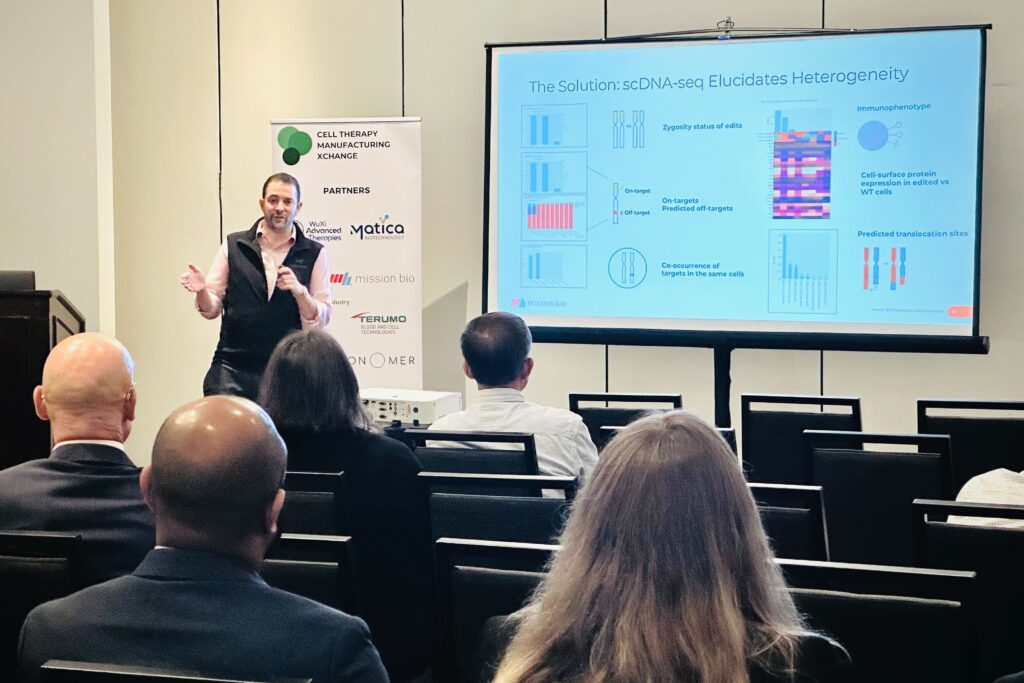June was a rich month for the cell and gene therapy community, marked by several high-profile conferences. The Allogeneic Cell Therapies Summit, CASSS Cell & Gene Therapy Products Symposium, and Cell Therapy Manufacturing Xchange provided platforms for industry leaders to discuss advancements, challenges, and the future direction of cell and gene therapies. Nori Ueno PhD and George Dorfman of the Mission Bio team had the privilege of attending these conferences, gaining valuable insights into the current state of the field. Here, they explore key themes, learnings, and directions from these conferences.
CASSS: Bridging Biopharma and Regulatory Bodies
At the CASSS CGPT Meeting, the presence of both biopharma companies and regulatory bodies highlighted a critical need for comprehensive characterization data. The prevailing sentiment was that developers must proactively build a robust matrix of assays from the outset. Nicole Verdun, director of the Center for Biologics Evaluation and Research’s Office of Therapeutic Products (CBER OTP) super office, emphasized that her goal is to facilitate the success of next-generation therapies. This success, however, hinges on empirical data that clearly delineates product safety and potency.
Despite a tendency within the field to look to regulatory agencies for a checklist of measurements, the responsibility lies with developers to ensure thorough characterization. This proactive approach is essential for the advancement of the field, as it allows regulatory bodies to better define success based on real-world data.
Cell Therapy Manufacturing Hub Xchange: Proactive Approaches to PD and Manufacturing
The discussions at Cell Therapy Manufacturing Xchange, held in Boston, echoed similar themes but with a focus on process development (PD) and manufacturing. Industrial leaders from companies like Vertex Pharmaceuticals, Kite Pharma, Bristol Myers Squibb, and Beam Therapeutics engaged in roundtable discussions, highlighting the importance of applying a proactive mindset to these areas. The consensus was that improved product understanding and educating regulatory bodies are crucial for advancing the field.

George DorfmanAssociate Director, CGT, presenting on how single-cell DNA sequencing identifies transduced versus non-transduced cells with exceptional accuracy and precision
Sponsors should feel invigorated by the opportunity to further develop their products and collaborate with regulatory agencies. The coming years will likely see a natural selection for programs led by those who embrace the latest characterization techniques. Investigators must be methodical and bold, ready to tackle the challenges of understanding and reconciling new insights.
The Role of Single-Cell Analysis
Single-cell analysis is playing an increasingly important role in drug product characterization. At the Allogeneic Cell Therapy Summit, Priya Chockalingam from Beam Therapeutics discussed the deployment of multi-modal single-cell methods for quantifying safety and efficacy attributes. These methods provide a framework for leveraging single-cell technologies in analytical development, regulatory, and clinical workflows to address critical endpoints and safety checks in a time-sensitive manner.
Mission Bio’s Tapestri single-cell platform is well-aligned with these needs. Our highly validated assays for transduction efficiency and vector copy number address the issue of diluted averages from ddPCR. Additionally, our upcoming Genome Integrity Assay, which surveys large chromosomal gains and losses at a genome-wide scale, has garnered significant interest from attendees.
Industry Challenges and Future Directions
Several recurring themes emerged from the conferences. The industry continues to grapple with proving the safety of manufactured drug products, managing manufacturing times, and properly characterizing master cell banks (MCBs). There is a sense that we are still “building the car as we drive it,” with regulatory agencies often seen as not providing enough communication and access despite new guidance documents.
Budget constraints are a significant concern, dictating what innovations sponsors can pursue while maintaining quality and safety. Although there is immense excitement in the industry and among patients, the focus must be on innovation and long-term success rather than short-term growth. This approach will ensure that regulatory knowledge evolves alongside the field, incorporating good practices in drug and regulatory design.
A Look Ahead
The conferences in June underscored the dynamic and evolving landscape of cell and gene therapy. Developers must take the lead in building comprehensive characterization data and adopting innovative single-cell analysis techniques. By doing so, they can advance the field, improve product safety, and ultimately deliver better treatments to patients.
Mission Bio is committed to supporting these efforts through our cutting-edge single-cell genomics technologies. We look forward to collaborating with partners old and new to elevate the field and drive the development of safer, more effective therapies. For those unfamiliar with single-cell genomics, we invite you to learn how we can work together to achieve these goals.










